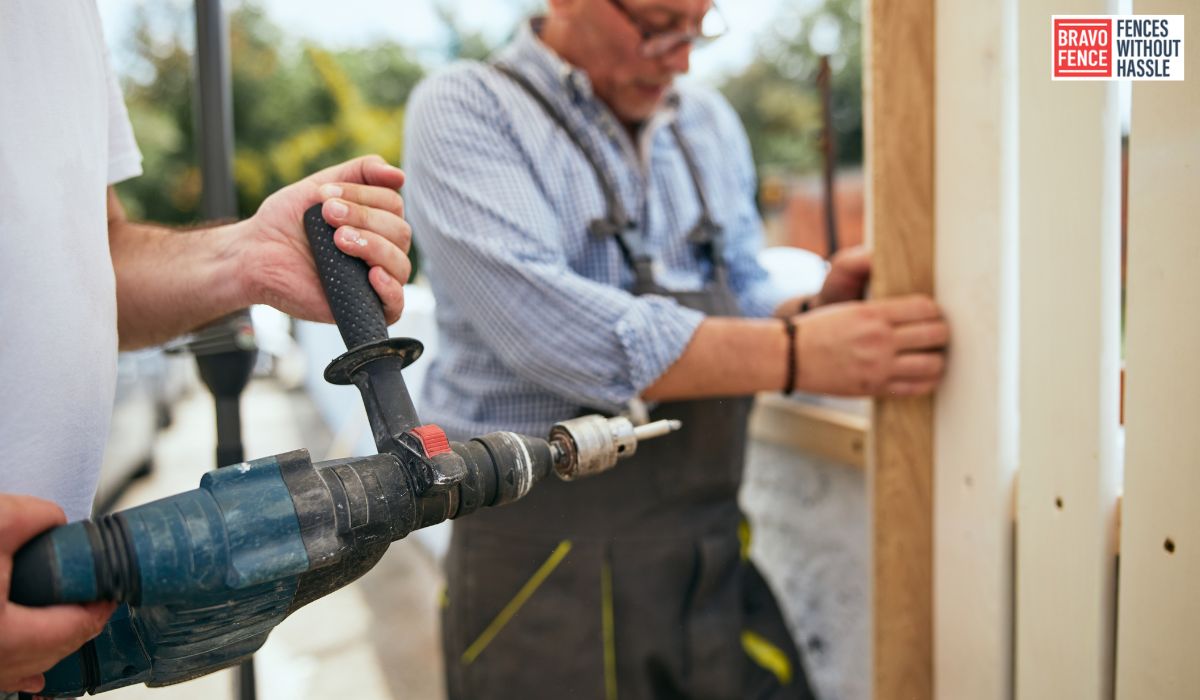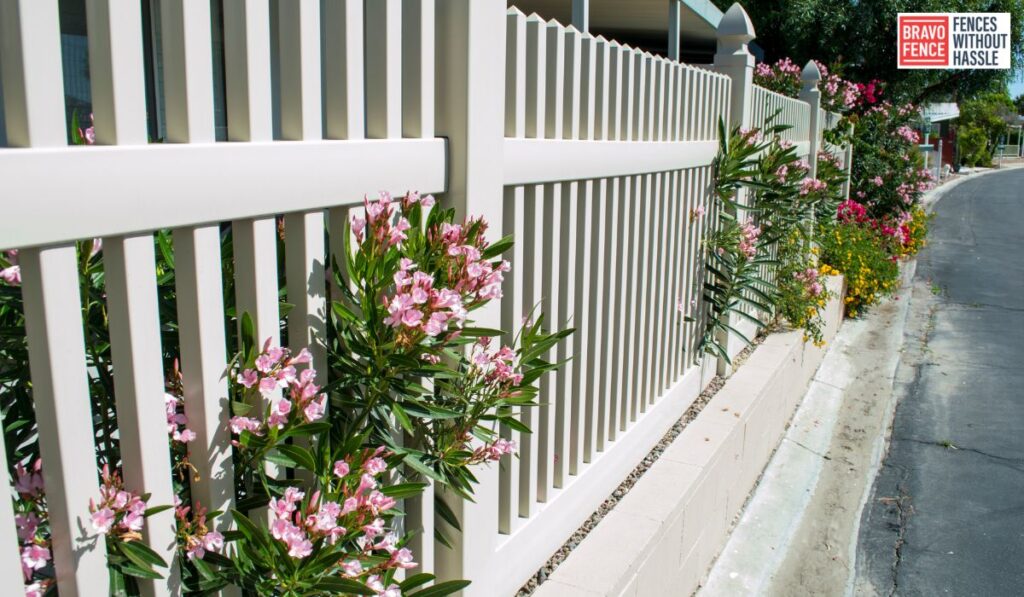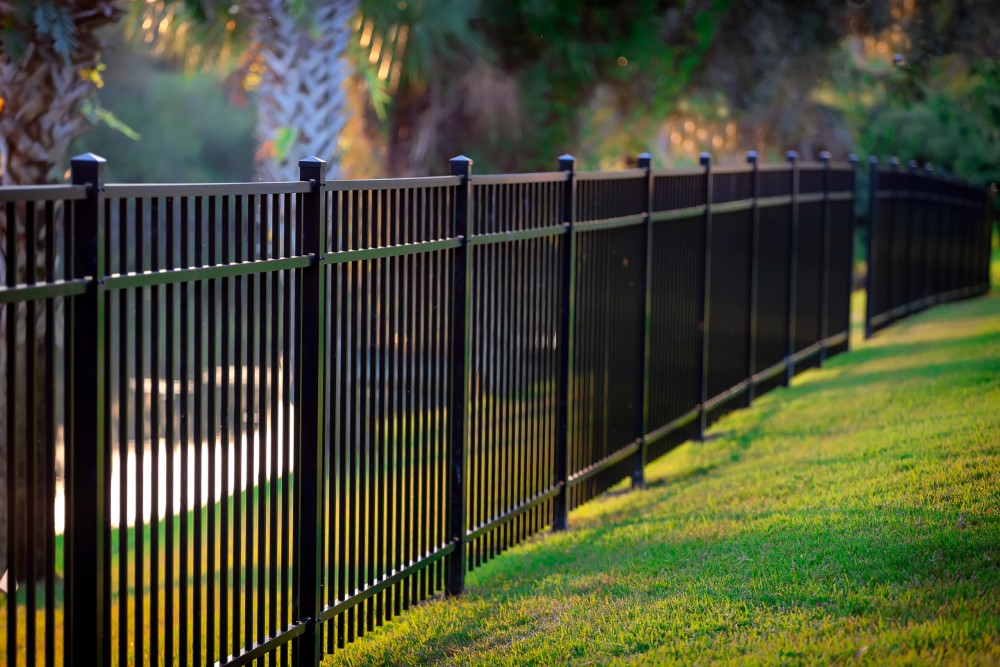
Installing A Vinyl Fence – Here’s The Breakdown Of Average Cost
When considering the installation of a vinyl fence, it’s essential to understand the associated costs.
The total expense will depend on several factors such as the size of the area, the type of vinyl fence chosen, and any additional features or customization.
On average, the cost per linear foot for a vinyl fence installation ranges from $20 to $40, including materials and labor.
However, it’s important to note that these prices may vary based on your location and specific requirements.
Factors That Affect The Vinyl Fence Installation Costs
Several factors influence the overall cost of installing a vinyl fence.
By understanding these factors, you can better estimate your project’s expenses and make informed decisions.
Here are the key factors to consider:
Fence Height and Length
The height and length of the fence play a significant role in determining the overall cost.
Taller and longer fences require more materials and labor, which can increase the total installation cost.
Fence Style and Design
Vinyl fences come in various styles and designs, such as privacy fences, picket fences, and ornamental fences.
The complexity of the chosen design and any additional features, such as lattice tops or decorative post caps, can impact the cost.
Site Preparation
Before installing the vinyl fence, the site needs to be properly prepared.
If the area is uneven or has obstacles like rocks or trees, additional labor and equipment may be required, leading to increased costs.
Accessibility
The accessibility of the installation site is another factor to consider. If the location is challenging to reach or requires special permits or permissions, it can add to the overall expenses.
Contractor’s Experience
The experience and expertise of the contractor you choose can influence the installation cost.
Highly skilled contractors may charge a premium for their services, but their expertise can ensure a high-quality and efficient installation.
Tips To Help You Save Money On Installing A Vinyl Fence
Installing a vinyl fence doesn’t have to break the bank.
With careful planning and consideration, you can save money while still achieving your desired results.
Here are some valuable tips to help you cut costs:
Compare Quotes
Obtain quotes from multiple contractors to compare prices and services.
This will allow you to choose the most cost-effective option without compromising on quality.
Opt for Simplicity
Choosing a straightforward and basic vinyl fence design can help reduce costs.
Intricate designs and additional features often come with a higher price tag.
Consider DIY Installation
If you have the necessary skills and tools, installing the vinyl fence yourself can significantly reduce labor costs.
However, keep in mind that this option requires careful planning and sufficient time commitment.
Buy in Bulk
If you’re planning to install a long stretch of vinyl fencing, purchasing materials in bulk can lead to substantial cost savings.

Check with suppliers or manufacturers for discounted rates on bulk orders.
Maintain Regularly
Proper maintenance of your vinyl fence can prolong its lifespan and save you money in the long run.
Regularly inspect the fence for any damage and promptly address any repairs or replacements needed.
Is It Worth To Install Vinyl Fence?
When considering whether to install a vinyl fence, it’s essential to weigh the benefits against the costs.
Here are some key advantages of vinyl fences that make them worth considering:
Durability: Vinyl fences are highly resistant to damage from weather, insects, and rot, ensuring long-term durability.
Low Maintenance: Unlike wood fences that require regular staining or painting, vinyl fences are virtually maintenance-free.
They don’t need painting, and occasional cleaning is usually sufficient to keep them looking pristine.
Versatility: Vinyl fences come in various styles, colors, and designs, allowing you to choose the perfect match for your aesthetic preferences.
Privacy and Security: Vinyl privacy fences offer excellent seclusion, keeping your property private and secure from prying eyes.
Cost-Effectiveness: Although the upfront costs of vinyl fences may be higher compared to other materials, their long-term durability and low maintenance make them a cost-effective choice.
Considering these benefits, installing a vinyl fence can be a worthwhile investment that adds value to your property.
Understanding The Factors that Influence Vinyl Fence Installation Costs
To make an informed decision about installing a vinyl fence, it’s crucial to understand the factors that influence the costs.
By considering these factors, you can plan your budget accordingly and ensure a successful installation.
Here are the key factors:
Location and Size: The geographical location and the size of the installation area affect the overall cost.
Fences in urban areas or regions with higher labor and material costs may be more expensive to install.
Fence Design and Style: The chosen design and style of the vinyl fence impact the installation costs.
Intricate designs and customized features can increase expenses.
Terrain and Ground Conditions: The terrain and ground conditions of the installation site can affect the complexity and labor required for the installation.
Uneven ground or rocky terrain may increase costs.
Permits and Regulations: Check if your local area requires permits or compliances for fence installation.
Obtaining the necessary permits adds to the overall expenses.
Additional Features: Accessories like gates, post caps, decorative inserts, or hardware can add to the installation costs. Consider these additions while planning your budget.
Evaluating The Cost And Benefits Of Vinyl Fence Installation
When evaluating the cost and benefits of installing a vinyl fence, it’s essential to consider both short-term and long-term factors.
Here’s a breakdown to help you make an informed decision:
Short-Term Costs:
Material costs for the vinyl fence panels, posts, and accessories
Labor costs for professional installation, if applicable
Permits and permissions, if required
Long-Term Benefits:
Durability and longevity, reducing the need for frequent repairs or replacements
Low maintenance requirements, saving time and money on upkeep
Enhanced privacy and security for your property
Aesthetically pleasing appearance that adds value to your home
By considering both the upfront costs and long-term benefits, you can assess whether installing a vinyl fence aligns with your budget and goals.
Conclusion
Installing a vinyl fence can be a smart investment for homeowners looking to enhance their property’s privacy, security, and aesthetic appeal.
By understanding the costs, factors that influence the installation, and ways to save money, you can make informed decisions and achieve a successful installation.
With its durability, low maintenance, and versatile design options, a vinyl fence can provide long-lasting value and enjoyment. So, if you’re ready to transform your outdoor space, consider installing a vinyl fence today!
FAQs
Can I install a vinyl fence myself?
Yes, you can install a vinyl fence yourself if you have the necessary skills and tools. However, it’s crucial to ensure proper alignment, secure post installation, and accurate measurements to achieve a successful installation.
How deep to dig for a vinyl fence post?
The depth to dig for a vinyl fence post depends on various factors, including the height of the fence and soil conditions. As a general guideline, dig a hole approximately 1/3 the length of the post. For example, if using an 8-foot post, dig a hole around 2.5 to 3 feet deep.
Do you need concrete to install a vinyl fence?
Using concrete to set the vinyl fence posts is recommended for added stability and longevity. It helps secure the posts firmly in place and prevents shifting or leaning over time.
What do you put under a vinyl fence?
To ensure proper drainage and prevent weeds from growing, it’s advisable to place a layer of crushed stone or gravel beneath the vinyl fence. This layer acts as a foundation and promotes better stability for the fence.
What is the disadvantage of a vinyl fence?
While vinyl fences offer numerous benefits, there are a few disadvantages to consider. One disadvantage is that vinyl fences can be more expensive upfront compared to other fencing materials like wood or chain-link. Additionally, vinyl fences may become brittle over time in extreme weather conditions.
Does a vinyl fence post need wood inside?
No, vinyl fence posts do not require wood inside. Vinyl fence posts are designed to be self-supporting and do not need additional reinforcement like wood posts.
Should a vinyl fence touch the ground?
It is generally recommended to leave a small gap between the bottom of the vinyl fence and the ground. This gap allows for proper drainage, prevents water accumulation, and helps avoid potential damage from contact with the ground.
Should you put gravel under a vinyl fence post?
Yes, placing gravel under a vinyl fence post can improve drainage and stability. The gravel layer helps prevent water from pooling around the post and minimizes the risk of shifting or leaning.
How many bags of cement do I need for a vinyl fence post?
The number of bags of cement required for a vinyl fence post depends on the size of the hole and the specific cement mix used. It’s best to consult the cement manufacturer’s instructions or seek advice from a professional to determine the appropriate amount for your project.
What is the difference between a vinyl and PVC fence?
Vinyl and PVC fences are often used interchangeably, as they refer to the same type of fencing material. Vinyl or PVC fences are made from polyvinyl chloride, a synthetic plastic material known for its durability, versatility, and low maintenance requirements.
Should fence rails be level or follow the ground?
Fence rails should generally follow the contour of the ground. This allows the fence to maintain a consistent height while accommodating any slopes or uneven terrain. However, it’s important to ensure that the fence remains level and visually appealing.

Do you need rebar in fence posts?
Rebar is not typically required for vinyl fence posts, as they are designed to be self-supporting. However, if you’re installing a vinyl fence in an area prone to high winds or other extreme conditions, adding rebar for reinforcement may provide additional stability.
Can you install a vinyl fence without digging?
While traditional vinyl fence installations require digging holes for the fence posts, there are alternatives available that allow for easier installation without extensive digging. Some options include surface-mounted posts or using specialized anchor systems designed for vinyl fences.
How do you anchor a vinyl fence post?
To anchor a vinyl fence post, you can use different methods depending on the specific installation requirements. Common options include using concrete, driving metal or PVC pipes into the ground, or utilizing surface-mounted brackets for secure attachment.
How do you keep a vinyl fence from sagging?
To prevent sagging in a vinyl fence, ensure proper installation by securely anchoring the posts and using appropriate spacing between posts. Additionally, using horizontal rails or reinforcement brackets can help provide added support and prevent sagging over time.
Do posts go on the inside or outside of the fence?
In most cases, the fence posts are installed on the inside of the fence line. This allows for a cleaner and more aesthetically pleasing appearance from the outside while providing structural support and stability from the inside.
How do you brace a vinyl fence against wind?
To brace a vinyl fence against wind, you can use several strategies:
Ensure proper post installation and secure anchoring using concrete or other suitable methods.
Increase the number of horizontal rails to provide additional support and stability.
Utilize wind-resistant fence designs, such as fences with narrow slats or staggered pickets.
Consider installing windbreaks or planting shrubs and trees near the fence line to create a natural barrier against strong winds.
Tags: Complete Guide to Diy Vinyl Fence, Complete Guide to Diy Vinyl Privacy Fence, Complete Guide to Installing Vinyl Privacy Fence, Complete Guide to Vinyl Fence Install, Complete Guide to Vinyl Fence Post Spacing, Everything You Need to Know About Build Your Own Vinyl Fence, Everything You Need to Know About Vinyl Fence Diy, Explore Helpful Resources on Install Vinyl Fence, Explore Helpful Resources on Vinyl Fence Assembly, Explore Helpful Resources on Vinyl Privacy Fence Installation
